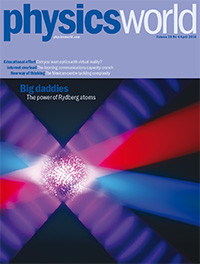Tag archives: complex systems
The April 2016 issue of Physics World is now live
 By Matin Durrani
By Matin Durrani
The April 2016 issue of Physics World magazine is ready and waiting for you to access via our app for mobile and desktop.
Our cover story this month is about Rydberg atoms – those super-sized atoms that are one of the hot topics in condensed-matter physics – and in particular how they could be used to create quantum computers.
You can also find out how virtual-reality tools could help you to learn about the science of optics and learn more about a new research centre at the National Autonomous University of Mexico that’s bringing a fresh approach to the science of complexity.
If you’re a member of the Institute of Physics (IOP), you can now enjoy immediate access to the new issue with the digital edition of the magazine in your web browser or on any iOS or Android mobile device (just download the Physics World app from the App Store or Google Play). If you’re not yet in the IOP, you can join as an IOPimember for just £15, €20 or $25 a year to get full access to Physics World digital.
Why electricity grids fail, what to do if your PhD is stolen, and what is a ‘Suris tetron’?
By Hamish Johnston
It’s the nightmare scenario for any PhD student: losing all those research results that you carefully squirreled away for when you finally sit down to write your thesis. That’s just what happened to biologist Billy Hinchen, who lost four years’ worth of 3D time-lapse videos of developing crustacean embryos when his laptop and back-up drives were stolen. Find out what happened next in “What would happen if you lost all of your research data?” by Julia Giddings at the scientific software firm Digital Science. Hinchen also tells his tale of woe in the video above.
View all posts by this author | View this author's profile
Partying bacterial biofilms throw out streamers
By Tushna Commissariat at the APS March Meeting in Denver
The word “streamers” doesn’t normally bring bacteria to mind, but it’s all the rage with biophysicists studying the mechanics of bacterial biofilms that grow where there is fluid flowing. A biofilm is any group of microorganisms where cells stick to each other on a surface – either a living or non-living surface will do. A rather simple example of this is the slimy film that develops over our teeth each night.
Biophysicist Knut Drescher from Princeton University gave a fascinating talk at the APS March Meeting on Monday about his research into why biofilms that grow specifically in the presence of a flowing fluid – such as in channels in soil, filtration systems, as well as medical devices such as stents or urinary catheters – are rapidly clogged, causing a variety of problems and infections. Biofilms in such a case form 3D thread-like “streamers” that are responsible for the rapid clogging. It was initially thought that these streamers formed along the walls of the original film and then expanded inwards, but Drescher and colleagues found that it was actually the other way around – the fishing-line-like streamers grew from the middle and rapidly extended outwards, clogging a channel within minutes.
View all posts by this author | View this author's profile
Magnetic supreme court judges, easier visa access, visualizing arXiv and more

From left to right, Lee talks about his supreme court model, as Alemi and Zeng listen in.
By Tushna Commissariat at the APS March Meeting in Denver
With the amazing variety of interesting talks at the APS meeting yesterday, I couldn’t possibly write up each and every one – I’d have to take today off, and there’s yet more physics to be learned today! In light of that, below is a short round-up of some of yesterday’s speakers and their work.
View all posts by this author | View this author's profile